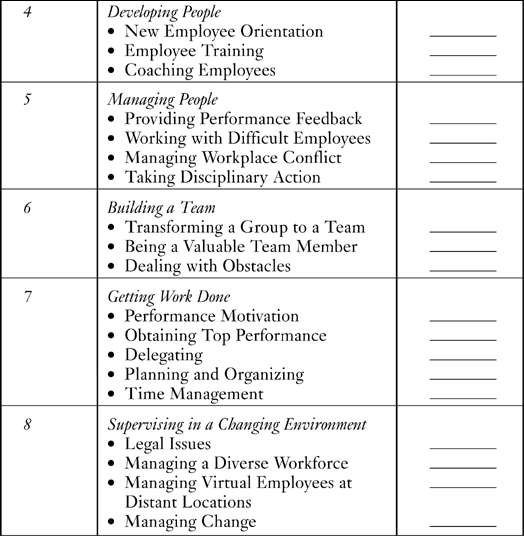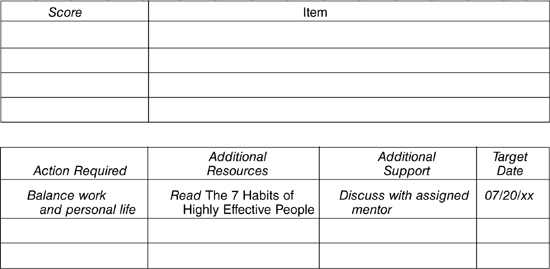9
Ensuring Your Success

Learning Objectives
By the end of this chapter, you should be able to:
• Reevaluate your confidence in making the transition from employee to first-line supervisor.
• Identify your skill areas that need additional development.
• Prepare a personal action plan for your first ninety days as a supervisor.
• Set goals for your ongoing professional development.
While reading and completing the exercises in this book you may have, at times, felt overwhelmed at how much there is to learn and what is expected of you. As you assume your new responsibilities, you will find that being a first-line supervisor is never boring: Every day you are likely to be faced with new problems to solve and new challenges to meet.
Regardless of how you feel right now, you can have a direct impact on your success by applying what you have learned. Research has shown that when people do not act on new learning within a few months, much of the learning tends to be lost. This chapter gives you the opportunity to review what you have learned, to build on your knowledge and skills, and to develop a plan to be successful.
REEVALUATE YOUR CONFIDENCE LEVEL
Let’s start at the beginning. In the first chapter you completed a self-assessment of your confidence level in making the transition from employee to first-line supervisor. Now that you have completed the first eight chapters, it’s time to reevaluate your confidence level. Your confidence level should have increased as your knowledge has increased. You have also had numerous opportunities throughout the course to think about ways to apply what you have been learning. This too, should have increased your confidence in making a smooth transition. The ten items in the exercise that follows are identical to the exercise you completed in Chapter 1. However, don’t look back at your earlier responses. This time you’ll be using the results to help develop a plan for your first ninety days as a first-line supervisor.
![]() Exericse 1: My Confidence Level
Exericse 1: My Confidence Level
INSTRUCTIONS: Read each of the statements below. Circle the number that is nearest to your confidence level on a scale of 1 to 10 (with 1 being “Not Confident” and 10 being “Very Confident”) in being able to make the transition from employee to first-line supervisor.
1. I can shift the focus from my area of technical or functional expertise to supervising other people.
![]()
2. I can make the transition from being a doer to ensuring work gets done.
![]()
3. I can handle multiple priorities at one time.
![]()
4. I can shift my focus from my job and my department to become aware of the entire organization and the role of individual departments and the relationships among departments.
![]()
5. I can shift my focus from the quality of my own performance to the quality and performance of the entire team.
![]()
6. I can handle working the extra hours that may be required in my new role.
![]()
7. I can make the transition from being an information receiver to being an information provider.
![]()
8. I can make the transition from being concerned about my own personal satisfaction to a concern for motivating and developing my employees.
![]()
9. I can make the transition from being a team member to being a team builder.
![]()
10. I can maintain a positive attitude when more demands are placed on me.
![]()
Evaluation
Refer to the Action Plan in Exhibit 9–1. Use Section A to identify those areas that you rated as 7 or less. These are items that require additional development during your first ninety days so you can make a successful transition to first-line supervision.
Set goals for yourself beginning in the Action Required column. Be as specific as possible in stating your goal. A sample is provided for your reference. Next, determine what additional resources you may need, such as reading a book, attending a seminar, subscribing to a magazine, etc. Then identify what additional support you may need. Support might come from your boss, a peer, a mentor, etc. In order to keep on track, set a target date for completing each goal.
Note: Keep your plan realistic. Do not set more than two goals in Section A to work on during the first ninety days. If you have more than two items you rated as 7 or less, prioritize the top two.
ADDITIONAL SKILL DEVELOPMENT
The higher your confidence level, the more likely you are to succeed as a first-line supervisor. In addition to confidence, you also must have the skills necessary to lead your team. The exercise that follows allows you to evaluate your skill level. The items in the exercise are based on the content of Chapters 3 through 8.
![]() Exercise 2: My Skill Areas
Exercise 2: My Skill Areas
INSTRUCTIONS: Review each Skill Area below. If you need to refresh your memory regarding the specific skills, refer back to that chapter in the book. Then write in the number that is nearest to your skill level on a scale of 1 to 10 (with 1 being “Not Skilled” and 10 being “Very Skilled”). Rate yourself on each bulleted skill area, not the overall category.


Refer to the Action Plan in Exhibit 9–1. Use Section B to identify those areas that you rated as 7 or less. These are skill areas that require additional development during the first ninety days.
Set goals for yourself beginning in the Action Required column. Be as specific as possible in stating your goal. A sample is provided for your reference. Next, determine what additional resources you may need, such as reading a book, attending a seminar, or subscribing to a magazine, etc. Then identify what additional support you may need. Support might come from your boss, a peer, or a mentor. In order to keep on track, set a target date for completing each goal.
Note: Keep your plan realistic. Do not set more than three goals in Section B to work on during the first ninety days. If you have more than three items you rated as 7 or less, prioritize the top three. Your total number of goals in both A and B should not exceed five. If you have more than five solid goals for your first ninety days you are probably not being realistic and are setting yourself up for failure.
You now have an Action Plan for your first ninety days in position. Take the initiative to schedule a meeting with your immediate supervisor to discuss your plan at the outset. Ask for additional recommendations, guidance, and support in making your plan realistic and meaningful. Then, keep your Action Plan where you can easily access it during your first ninety days in position. Review it weekly to be sure you are making the necessary progress in achieving your goals. If you get off track, make appropriate adjustments and review the plan again with your immediate supervisor.
ONGOING PROFESSIONAL DEVELOPMENT
The frequency with which you pursue formal ongoing professional development will vary. It is recommended that you begin by completing a review after your first ninety days on the job. The timing of your next review depends on how you and your immediate supervisor feel about your development at that point. You may want your next follow-up plan to be for three months, six months, or a year. The timing may also depend on any organizational requirements for performance review and action plan development.
An important source for ongoing development is coaching and guidance from your immediate supervisor. If he or she provides you with regular feedback, be thankful. Many people receive only limited feedback from their bosses and what they do receive tends to be negative. If you aren’t getting feedback from above, take the bull by the horns yourself. Go to your boss and ask for help. But do so only if you really want help. Remember the saying, “Be careful what you ask for—you just might get it.” An experienced and successful boss, however, can be an excellent source for your own personal development.
Your peer group can be another place to go for ongoing development. Look around and find out which first-line supervisors are successful. Ask them to explain what they have found that works well for them. It may not work 100 percent for you, but some of what they do may be applicable. Peers are likely to have similar problems and experiences to yours. Their insight can be valuable as you develop your own knowledge, skills, and abilities.
Don’t forget your employees and team members. If you interact with them on a daily basis, they probably know you better than anyone else. Use team meetings to ask for input and suggestions on ways to improve. If you are open about wanting their participation in your development, they will willingly provide you with feedback about your performance.
The evaluation and goal setting process described in this chapter should be an ongoing developmental activity. Personal growth occurs when you take time to ask hard questions about how you are doing, listen to the responses, and then make a concerted effort to improve performance. Over time this continual process of feedback and evaluation leads to professional growth and the development of important leadership skills.
This chapter was designed to provide you with an opportunity to prepare yourself for your first ninety days on the job as a first-line supervisor. You were asked to make an assessment of your confidence level and your skills areas. Based on your assessment you developed an action plan with specific goals for your first ninety days.
You were also challenged to make evaluation and goal setting an ongoing professional development activity. It was pointed out that personal growth occurs when you take time to obtain serious feedback from others and then make a concentrated effort to improve your own performance. This continual process of feedback and evaluation can keep you headed in the right direction and help you achieve your long-term goals.

 Exhibit 9–1
Exhibit 9–1



 Review Questions
Review Questions